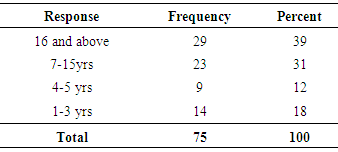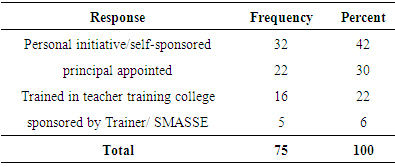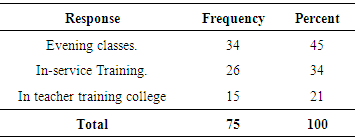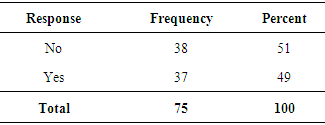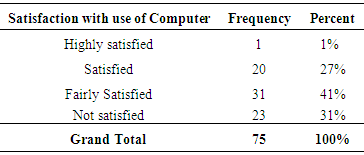-
Paper Information
- Paper Submission
-
Journal Information
- About This Journal
- Editorial Board
- Current Issue
- Archive
- Author Guidelines
- Contact Us
Human Resource Management Research
p-ISSN: 2169-9607 e-ISSN: 2169-9666
2015; 5(4): 77-94
doi:10.5923/j.hrmr.20150504.01
Impact of Teacher Training on Information Communication Technology Integration in Public Secondary Schools in Mombasa County
Gertrude Mariam Chao
Jomo Kenyatta University of Agriculture and Technology, Department of Entrepreneurship and Procurement, Mombasa, Kenya
Correspondence to: Gertrude Mariam Chao, Jomo Kenyatta University of Agriculture and Technology, Department of Entrepreneurship and Procurement, Mombasa, Kenya.
| Email: |  |
Copyright © 2015 Scientific & Academic Publishing. All Rights Reserved.
The objective of the study was to find out how effective the ICT training received by teachers is, in assisting them to integrate ICT in their work to make it more interactive, interesting, and innovative. Even though there is a shortage of ICT infrastructure in most schools in Kenya, the biggest problem is that, even in the few schools with adequate infrastructure, teachers lack the necessary training to enable them to use the facilities to enhance learning. 88% of the respondents in this research indicated that they have computers in schools. Teacher ICT training is haphazardly done due to lack of policy and standards.
Keywords: Training, Information communication technology (ICT), ICT Integration
Cite this paper: Gertrude Mariam Chao, Impact of Teacher Training on Information Communication Technology Integration in Public Secondary Schools in Mombasa County, Human Resource Management Research, Vol. 5 No. 4, 2015, pp. 77-94. doi: 10.5923/j.hrmr.20150504.01.
Article Outline
1. Introduction
1.1. Background of the Study
- The world is being taken over by the storm of the twin forces of Globalization and technological changes .The past fifteen years have seen a new global economy being created which is “powered by technology, fueled by information and driven by knowledge” according to Tinio (2002). As technology is changing global economy, Education which is a major sub-system in that economy has not been spared by this wave of change. From time immemorial, education has been viewed as a very important vehicle for managing change and this is the reason why the changes in technology have to be infused in education then education takes them to all sectors through the graduates of the education system. ICT has played a pivotal role in modern societies, and economies and therefore its introduction into secondary schools is high on any government’s political agenda be it developed or developing country. ICT has also been used to improve access to education and the quality of teacher training as stated by Crisan (2004). ICT-enhanced learning mobilizes tools for examination, calculation and analysis of information, thus providing a platform for student inquiry, analysis and construction of new information. Research has proved that ICT cannot be integrated into teaching and learning without preparing the teacher for the ICT up take. An effective teacher ICT training should have four approaches as illustrated in the diagram below.
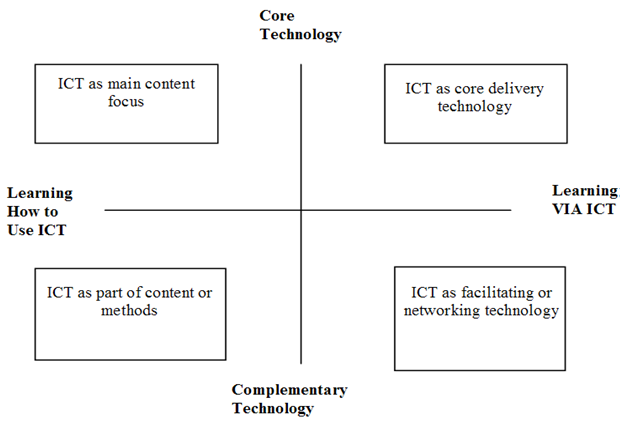 | Figure 1.1. Categories for ICT in teacher training. (Source: ICT–pedagogy integration in teacher training, application cases worldwide, Educational technology & society. Jung 2005) |
 | Figure 1.2. Mapping teaching and learning to stages of ICT integration (Source: UNESCO Bangkok 2005) |
1.2. Statement of the Problem
- Teachers are expected to be well trained and confident in the use of computer-related technology in the classroom and in other professional activities. They need to take education and indeed the world economies to the next level yet they lack the knowledge, the means and the right attitude to do so. Despite the training that teachers have received at pre-service and in the in-service training they are still unable to integrate ICT in the teaching and learning of their subjects. They are also unable use ICT for professional development hence the rate of ICT integration in Education has remained slow and not in tandem with immense technological tools that have been developed for use in Education. Teachers go through many trainings that focus on computer literacy but which do not enable them to integrate ICT in their day to day activities and use it as a tool to improve teaching and learning as observed by Ng, Miao, Lee (2009). ICT is supposed to impact on components of education system for any development to be realised, and these are, curriculum and assessment, pedagogy, ICT (technological use), school organization and administration and Teacher Professional Development (TPD).Secondly the ICT infrastructure is lacking or is inadequate so the teachers cannot apply the knowledge and skills learnt in their training adequately. The developed, countries like Finland, Korea and Ireland are at advanced level of the ICT integration in Education. In these countries access to computers has been achieved, all schools are connected to the internet and a lot of digital materials are being produced and utilized in the classes. The situation contrast sharply with the situation in Kenya. Ministry of Education policy document on ICT Kenya (2006) reported that ‘While the ratio of one computer to 15 students is the norm in most developed countries, the ratio in Africa stands at one computer to 150 students’. This ratio is even wider in disadvantaged regions and areas. Another problem is limited time that the teacher has for training hence most ICT courses that are organised for the teachers are usually short and not comprehensive enough. Teacher training college ICT content does not prepare the teacher to integrate ICT in teaching their subjects in secondary schools. The teacher educators in teacher training colleges and universities are not good role models, for they do not use ICT in their lectures. There is also lack of motivation for teachers to train since most of the time they are forced to sponsor themselves for the courses. There is a problem with the attitude of teachers, in that some of them are conservative, such teachers ‘have been holding out for a lot longer than ten years against the forces of constructivism and the proponents of student-centered learning, Wahyudi (2007) observed. These teachers are analogized as the defense walls of troy city, what is needed for protection against pedagogical Trojan horse’ that will break down the wall, but the big problem is how this can be achieved. Teachers are also not motivated to take ICT to their classrooms. As technology advances and teaching job becomes more challenging to the teacher, ICT provide some of solution to some of the challenges teachers face in their work. Though new technologies increase teachers’ training needs, they also offer part of the solution, this has been hinted by Jung (2005). Information and communication technology (ICT) can provide more flexible and effective ways for professional development for teachers, improve pre- and in-service teacher training, and connect teachers to the global teacher community’ but teachers are failing to take advantage of these opportunities presented by ICT for their professional development.
1.3. Objectives
1.3.1. General Objectives
- To investigate whether, teacher’s training in ICT has an impact on integration of ICT in schools.
1.3.2. Specific Objectives
- 1) To establish whether training needs assessment is done to determine the type of ICT development program required. 2) To determine the modes of ICT training programs that is offered to teachers in Mombasa County. 3) To identify the ICT infrastructure available in secondary schools in Mombasa County.4) To find out the challenges teachers face in the use of ICT in schools in Mombasa County.5) To make recommendation for improvement in ICT integration in secondary schools Mombasa County.
1.4. Research Questions
- (1) Is needs assessment done for ICT training programs offered to teachers’ in Mombasa County? (2) What modes of ICT training programs have been offered to teachers in Mombasa County?(3) Which ICT infrastructures are available in secondary schools in Mombasa County? (4) What are the challenges that teachers face in the use of ICT in schools in Mombasa County?(5) What are some of the ways in which the use of ICT in Mombasa County can be improved?
1.5. Justification
- The researcher, being a teacher herself recognizes that, an ICT literate workforce is the foundation on which a country can acquire the status of a knowledge economy and that, education is the natural platform for equipping the nation with ICT skill. The role of the teacher in developing an ICT- literate Workforce cannot be underestimated because all the students are modeled by the teacher hence the need to train them adequately so as to be competent, confident and creative in the use of ICT, and this will bring up a generation that is enthusiastic about ICT. The researcher also underscores the importance of ICT application in learning and believes that it can improve the results of students a great deal, not only in computer studies but in all the other subjects.This research study identifies some of the problems that make ICT trained teachers fail to integrate ICT in education therefore the study will benefit the ministry of education and donor partners interested in ICTs in education who will use the study to develop interventions that will enhance ICT training programs, so that they focus on improving the quality of learning as well as educational efficiency and relevance by building the capacity of teachers to integrate ICTs into teaching. This research is an added voice, to the cry for better access to ICT infrastructure in various secondary schools and hence, it influences both the ministry of Education and the donor community to redouble their efforts in provision of the relevant ICTs in schools where it is inadequate or lacking altogether. Other researchers may use the study findings to further research on how ICT teacher training impacts on ICT integration in schools and how training can be improved. The research will assist educational officers, teachers, students and other interested parties to understand and appreciate the significance of ICT teacher training in influencing how ICT is used it in schools.
1.6. Scope
- The study targeted secondary school teachers in public secondary schools within Mombasa County (the former Mombasa District). The respondents were teachers who have been trained in atleast basic ICT courses.
1.7. Limitations
- The researcher was given permission out of the station only in the afternoons to collect data; this was after doing her duties in the morning session, hence time was a limitation. To avoid the problem of having many respondents who have not trained in ICT filling the Questionnaire and giving irrelevant data, purposive sampling technique, and to be specific judgment sampling was used by the researcher to ensure that only those who have trained in ICT provided the data.
2. Literature Review
2.1. Introduction
- This chapter discusses the literature related to the impact of training on ICT integration in secondary schools in Mombasa. It particularly focuses on ICT Training need assessment, Modes of ICT training programs for teachers, ICT infrastructure in education, Challenges faced by teachers in ICT integration, Recommendations for improvement of ICT integration in secondary schools.
2.2. Theoretical Framework
- A lot of research and writing has been done concerning the issue of ICT teacher training and ICT integration. This study was guided by pedagogical approach to teacher training as the best means of achieving ICT integration in schools. In this theory the teacher integrates ICT better, if they are trained on how to teach their subject using technologies. This idea is clarified further by IAP (2005) USEIT survey that was conducted to establish and compare technology use patterns of teachers who had taught for over five years with those that have taught for less than five years. Rosell et al (2003) observes that naturally it would be expected that the teachers who have taught for under five years to use technology to teach more than their senior counterparts because they are just fresh from training and most probably would have received an up to date or more comprehensive ICT training. The survey results revealed that the teacher who have worked for less than five years, though more confident in using technology they used less of it in class and more of it in outside class activities. Though their senior counterparts were less confident in using technology they used more of it for instruction in class.Teachers who have taught for fewer years are expected to be better trained and more enthusiastic in using technology where it matters most, and that is in classroom, yet the study had revealed otherwise. Was the ICT training inadequate? The researcher wants to find out whether the same situation is replicated in Mombasa County with a view to Identifying ICT integration challenges and solutions. This is where the researcher at hand found a gap to be investigated. In this research the researcher was out to find determine how ICT training influences ICT Integration in secondary schools in Mombasa County.
2.3. Conceptual Framework.
- The researcher has conceptualized that ICT training, if done right can increase the use of ICTs in teaching in secondary schools and hence improve the performance of both the teacher and the students. This entails an assessment of teacher ICT training needs, training programs designed according to need, modes of training selected according to needs, the right ICT infrastructure provided at training level and after training, and ICT integration challenges identified and solved amicably.
 | Figure 2.1. Conceptual frameworks |
2.3.1. ICT Training needs Assessment
- Training is the use of systematic and planned instruction activities to promote learning. The approach can be summarized in the phrase, ‘learner-based training’, this is according to Armstrong (2008). Training is any learning activity which is directed towards the acquisition of specific knowledge and skills for the purposes of an occupation, as defined by Cole (1978). Training is also a process designed to maintain or improve current job performance.In this study the focus is on teacher ICT training which shall be defined as a process through which a teacher acquires knowledge and skills to use ICT in teaching their subject for better performance. Training is required when there is poor performance or changes have occurred in the job and therefore employees require new skills to do the job. For training to be successful it has to be done systematically. A system of training that involves five stages; Analysis, Designing, Developing Implementing and Evaluation, has been described by Rosette (1987). Before teachers are taken for any ICT training, an assessment of their needs is supposed to be done so that the training program is tailored towards meeting those needs. Steps involved in undertaking a training needs analysis are as follows: Clarify the goal, identify the target group, identify the skill set required, determine the current skill level, determine the skill level required, determine the skill gap, develop a training plan including dates, training strategy and resources required. An ICT needs assessment is done per individual teacher, using a questionnaire entailing the various skills the teacher ought to have. The teacher fills the questionnaire declaring the skills they possess and the skills they lack, then data in the questionnaires is analysed and programs are designed to suit the needs. In Kenya however, there has been a problem of lack of ICT teacher training needs assessment which has forced most teachers to train in ICT courses that are initiated by trainers, ICT vendors, donors or government even when such programs don’t suit their needs.
 | Figure 2.2. Stages in training need assessment (Source: Training needs Assessment, Rossette 1987) |
2.3.2. The Modes of ICT Training for Teachers
- There are several modes of training available to teachers, some of them are:
2.3.2.1. Pre–Service Training
- Due to the importance that is attached to ICT in the word today it has become inevitable to include ICT training in Teacher training institutions. Most teacher training colleges have ICT units incorporated in their curriculum. Research has however indicated that the ICT training in the pre-service is not helping much in the integration of ICT in education mainly because teachers are not taught how to integrate ICT in their teaching instead, they are taught computer literacy.
2.3.2.2. In-Service Training
- Teachers who graduated earlier from college missed the opportunity to train in ICT and out of these, those who find themselves in the need to upgrade their skills normally find refuge in the ICT training courses which they can pursue during breaks from work. Teachers attend such courses in the evening after work or during their vacation. These in-service courses have been criticised for been too brief and most of the time they are rushed because there is too much content to be taught. The trainee teachers ends up being frustrated and some give up on training in ICT.
2.3.2.3. Online Training
- This is one the most modern form of ICT teacher training mode, also referred as computer based learning or E-learning. Basal (2009) terms it as most flexible and effective way of life long professional development for today’s teachers. This method entails learning ICT modules in CD ROMs, or by use of digital television or PDA and mobile phones. This mode of learning can also be conducted by use of internet where learning programs can are emailed, discussion forums, collaborative class management and team learning systems have greatly enhanced long distance teacher training and has made it flexible, where just–in-time learning meet teacher’s specific need.
2.3.2.4. On- the- Job Training/in House Training
- Tailor made ICT courses are offered to teachers at their work stations, these are geared to address specific ICT challenges that are faced by teachers in a school. The emphasis here is more on the organization of specific knowledge in real situation using the organizations facility (Cole 1997).
2.3.3. ICT Infrastructure for Schools
- ICT infrastructure in a school set up includes but not limited to, radio broadcasting, digital television, computers, projector, internet connection, video conferencing facilities, websites and ICT software relevant in Education. An effective teacher training must expose the teacher to the ICT tools that they will meet in class as this will boost their confidence in teaching using those tools. For the teachers to transfer the skills they have learnt, they need to have the ICT infrastructure. In today’s world where technology is changing rapidly there is need for every secondary school to be equipped with computers in class and be connected to the internet. ICT integration in this paper is broadly defined as a process of using any ICT (including information resources on the web, multimedia programs in CD-ROMs, learning objects, or other tools) to enhance student teaching (Williams, 2003). ICT tools are many in use in school but to make this study less complicated, ICT will refer to the use of computer and internet connection. The level of ICT integration can be determined by what kind of ICT infrastructure is available in the schools and how it is being used in teaching and learning process. This can be brought out clearly by articulating the digital gap that exists between the developed and developing countries.The developed countries are geared towards ICT-enhanced learning, mobilizes tools for examination, calculation and analysis of information, thus providing a platform for student inquiry, analysis and construction of new information. Learners therefore learn as they do and, whenever appropriate, work on real-life problems in-depth, making learning less abstract and more relevant to the learner’s life situation. Such ICT-enhanced learning promotes increased learner engagement as well as “just-in-time” learning in which learners can choose what to learn when they need to learn it.While developing countries have reported up to 41% of integration of ICT to teaching and learning, the proportion remains substantially low in Africa, Kenya included as indicated by Ministry of Education (2006). Access to computer and other ICTs remains a big problem and thus the low levels of use of these tools in the schools. While the average ratio of computer to student is reported to be one to 15 students in developed countries in developed countries, and in Kenya for that matter, it is about one to 150 students.
2.3.4. ICT Integration Challenges and Solutions to the Challenges
- ‘A school can have the best software ever made and access to the Web on every computer, But it won't see much difference in student learning, experts say, unless its teachers know how to use the digital Content in their classrooms”. “I could put the same software into two classrooms, and in one classroom, it's used horribly, and in the other classroom, it's fantastic. It's all got to do with the teacher," says Gregg Martin, the technology director at Addison Central Supervisory Union, a school district in Vermont's Champlain Valley, as reported by Trotter (1999). The statements above underscore the importance of a teacher in integrating ICT and in the implementation of a digital curriculum and dilute earlier notion that modern ICT will replace teachers in the classroom. It instead emphasises the fact that teacher’s role is now more than ever, embedded into the system. Teacher’s role has to ‘change, from being the sole voice of authority to that of a facilitator, mentor and coach’ since ICT has increased student participation in class and opened up classrooms to the outside world as observed by Tinio (2002).Research has shown that use of ICT can make learning more interactive hence can support new instructional approaches and make hard-to-implement instructional methods such as simulation or cooperative learning more feasible as presented by (Roblyer, Edwards, & Havriluk, 2004). ICT cannot be integrated in education without the teacher, ‘Teachers are key to whether technologies are used appropriately or not’ (Carlson & Gardio 2002). Most research findings are in agreement that not just a teacher is instrumental in ICT integration in teaching and learning, ‘appropriate and effective use of technologies involves competent, committed interventions by people’ the people are the teachers declares Haddad (2007). Most of the researchers, have indicated that appropriate teacher training in ICT has a positive effect in integration of ICT in Education as these make the teachers prepared, comfortable and motivated to use ICT in teaching their subjects William (2000). In some reported cases ICT training for teachers has failed to yield result due a number of problems. A research using survey design methodology to examine the nature and impact ICT training offered by teacher educators, was conducted by Jegede (2009) and found out that lack of need assessment lead to irrelevant, none ICT integration focused courses being offered by teacher training institutions. Organistions and donors have come up with programs that are either obsolete or inadequate and are not focus on the ‘how to use ICT’ hence do not prepare the teacher to meet the new requirements in modern education, which require the teacher to according to Bevernage et el (2002) to ‘use ICT to learn’. Most of the courses offered are short and are mainly geared to providing the teacher with basic computer literacy skills. It is unfortunate that the design of teacher-educator curriculum lies primarily with the category of people who themselves were minimally informed on ICT concepts, let alone its integration in Education Jegede (2009) observes. Other factors that make teachers not to effectively use ICT includes and not limited to ‘poor software development, skepticism on effectiveness of computers in improving learning outcomes, lack of administrative support, more time and effort needed to learn the technology and how to use it for teaching, and teachers’ fear of losing their authority in the classroom since technology makes it more learner centered’ according to Hannafin & savenye (1993).Survey findings of ImpaCT2 (Harrison 2002) attest to the fact that ICT is having a major impact on education and hence been regarded as an important means through which access to education and improvement in quality of education can be improved. Most developing countries that have lagged behind in ICT like Kenya are now, ‘firmly on the path to establishing digital learning in schools to boost quality and access of education countrywide’ as reported by Ratemo (2011).
2.3.5. Solutions to ICT Integration in Schools
- Some of the solutions have been highlighted while discussing the challenges above. Problem of lack of infrastructure have been solved by governments partnering with the private sector to sponsor the acquisition of the facilities by the schools and also by setting up digital centers that can be used by a whole community, schools included. Most of the governments have the issue of ICT integration in education embedded in their national ICT policy and where it is given all the political support required. Another solution is in restructuring of teacher ICT training to include training in the use of ICT in all educational processes but giving more emphasis to ICT uses in pedagogy. Teacher ICT training policy is required to ensure the required standards are set, strategies formulated, and training process monitored to ensure training objectives are met.
2.4. Summary
- Though Training of teachers in ICT can assist in integration of ICT in schools the rate of change is going to remain slow until the education systems and policies are changed to be more accommodative of ICT. As it is now integrating new technologies into old or traditional systems is like putting new wine into old Wineskins and they might burst. However the change should be introduced gradually. Research indicates that change at all levels will be necessary to bring about widespread and effective use of technology. Educational programs must devote a substantial portion of their budget to extensive teacher professional development and technical support; they must encourage a culture of collaboration in which teachers work together to explore more effective uses of technology; and they must modify their assessment systems to measure changes, such as deeper understanding and improved problem solving, that result from effective technology use.
2.5. Research Gaps
- There are many researches that have been carried out that have given prominence to training in ICT, some have tended to deal with the issues of ICT integration, while still many have highlighted or dealt with the issue of training as a barrier of ICT integration in schools. One of the researches that are relevant to this research is the one done by Jegede (2009), an assessment of Nigerian teacher educator’s in ICT that examined the nature and impact of trainings received by teacher educators in south western Nigeria teacher training institutions. A population of 500 teacher educator selected randomly was used, from 6 colleges and 6 universities. The researcher used Questionnaires, (TICQ), teachers use check list (TICTUC), and teachers competence scale (TICTCS). The study conducted by Jegede is similar to this one in that, both studies were focused on the influence of training of teachers on their rate of use of ICT in teaching and learning. However Jegede’s research differs from this research in that his focus was on teachers who were still on training but this one was focused on teachers who are through with training and are already practicing. Jegede in his finding cited the inadequate ICT educator’s curriculum as being responsible for little impact felt in the classrooms in terms of ICT use. While with him on this, there is need to explore further to get other factors responsible for low use of ICT in the classrooms. Another research that is relevant to this study is that of Bevernage Bart.c, & Ngaga (2005), Integrating ICT: Reflections on practice and policy implications, A case study of the learning Resource centre at the Kenya technical Teachers college. This study is similar to mine because it was out to assess the impact that ICT teacher training has on the use of ICT in schools. The case study however differs from the one done by Jegede and the one at hand because it is based on a single institution as opposed to a sample of many institutions, the study also emphasized on access to ICT and ICT policy as the main factors that determines the use of ICT by teachers in class while the other two hinge more on training of teachers in ICT as the factor that increases the use of ICT to teach.The two researches described above hints that there could be a lot more factors causing low rate of integration of ICT in the classes and Training of teachers is a major one. Jegede’s research design is more applicable for this study than the case study. Most Researches that have sort to study the influence or effect of training in ICT integration have been done in developed countries and the focus has been on mainly the Teacher educators and teacher trainees in colleges. According to the literature review I did found a research gap in linking teacher ICT training and ICT integration in learning at secondary school level in a developing country like Kenya. Research was required in this area to be able to paint the picture of how far behind the developing countries are lagging in ICT integration in education and find out how they can fast track the process to be able to evolve with the ever changing technology.
3. Methodology
3.1. Introduction
- This chapter comprises of, research design, population, sampling frame, sample and sampling technique, instruments, data collection procedure, pilot test ,data processing and analysis.
3.2. Research design
- This study has employed mainly qualitative strategy with a survey research design. The study was concerned with the impact of teachers training on the integration of ICT in secondary school education in Mombasa County. It intended to show the relationship between teachers training on ICT and integration of ICT in teaching and learning in public secondary schools. This study covered the whole of Mombasa with about 23 public secondary schools that are spread throughout the county. Survey was suitable for this extensive research because it entailed investigating populations by selecting samples then generalizing results to the whole population. The limited time and resources made survey design most suitable for this study than any other.
3.3. Population
- The population of the study comprised of 800 teachers teaching in public secondary schools in Mombasa County. This target population was chosen because it’s made up of trained teachers who were implementing the same curriculum, and employed and remunerated by the same employer that is, teachers service commission. This target population was appropriate because it meant that the respondents were working under more or less same environment and influenced by same factors.
3.4. Sampling Frame
- Due to limitations in time and financial resources the whole population could not be used as respondents, a sample consisting of 80 respondents was selected from estimated 800 teachers teaching public secondary schools in Mombasa County. This sample of 80 respondents is 10% of the estimated target population, this is an ample sample as advanced by Gay (1981) quoted by (2003) Mugenda & Mugenda where he stated that, ten percent of the accessible population is enough for descriptive research studies.
3.5. Sample and Sampling Technique
3.5.1. Sample
- The sample comprised of 80 teachers teaching in public secondary schools in Mombasa County. The sample was found to have the following characteristics; they were employed by the same employer, they were all teaching in public schools and had a form of basic training in ICT.
3.5.2. Sampling Technique
- A source list with names of all secondary schools in Mombasa County was obtained from the Provincial director of Education’s office. The researcher used multi–stage sampling in which a random sample of eight public secondary schools from Mombasa County was selected. Name of all public secondary schools in Mombasa County were written down, each in a separate piece of paper then using lottery method, eight schools were selected. 80 respondents were then selected purposively from eight selected schools in Mombasa County so as to get a sample of only ICT -trained these made up respondents.
3.6. Instruments
- Questionnaire was mainly structured as it had more closed-ended questions, only two questions were open-ended. The questionnaire had a total of 14 items, 3 items were on personal information of respondents, 2 items were on training needs assessment,4 items were on modes of training, 3 items were on ICT infrastructure available in schools, 1 item on challenges of ICT integration, and 1 item on Solutions to ICT integration challenges. The items on challenges and solutions to ICT integration were open-ended questions and the rest were closed- ended. Questionnaire method of collecting data was chosen for this research because all the respondents were literate hence there was no difficulty in filling the questionnaire. Questionnaires are also most suitable for collecting a lot of data when time is limited. This research was mainly concerned with variables that cannot be directly observed like training, such information is best collected by questionnaire.
3.7. Data Collection Procedure
- Data that was collected was qualitative from a sample size of 80 respondents, and from a target population of estimated 800 teachers in public secondary schools. Data was collected using Questionnaire method. Questionnaires were administered to teachers who had already undergone at least basic training in ICT. These questionnaires had mainly closed- ended questions and only two open-ended questions. The questionnaires were personally administered to the respondents by the researcher since the sample size was small.
3.8. Pilot Test
- Pretesting is necessary especially when the study is complex and sample is large and where resources (money and Time) are available, that is according to Mugenda & Mugenda (2003). This study was neither complex nor was the sample large hence it would be uneconomical to pilot the study. Instead five questionnaires were being given to five teachers to fill so as to check for any weakness in the questions such as ambiguity or any other error. There were no major error the minor errors were rectified.
3.9. Data Processing and Analysis
- The researcher organized the collected data into various constituent parts, coded it then used Microsoft Excel software for qualitative analysis. Data was analysed using descriptive statistic methods, mainly percentages and frequencies. Data was been presented by use of frequency tables and charts.
4. Results
4.1. Introduction
- This chapter presents the findings after the data collection instruments were administered to the respondents. The data gathered was summarized into tables and frequencies were generated. The findings were then analysed and discussed based on the objectives and finally the research questions were answered.
4.2. General Information
4.2.1. Gender of Respondents
- The respondents were asked to indicate their gender. The responses are as presented in Table 4.1 and figure 4.1.
|
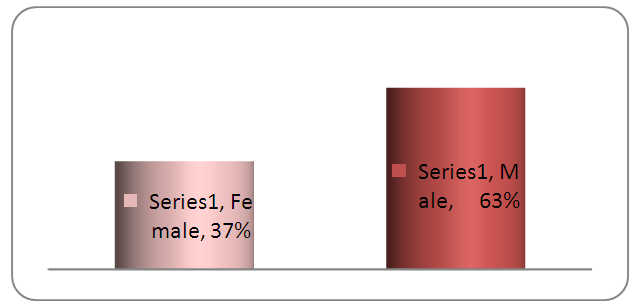 | Figure 4.1. Gender |
4.2.2. Subjects Taught
- Respondents were asked to indicate their teaching subjects, the first subject indicated was assumed to be the major teaching subject for the respondents hence picked for analysis. Highest percentage of respondent was mathematics teachers comprising of 20%, followed by Kiswahili teachers and English teachers each at 11%, while the least were, computer studies, accounting, and drawing and design. Mathematics and languages teachers form the highest percentage of respondents. This could imply that more mathematics teachers have trained and embraced ICT in class than teachers of other subjects. The results are as indicated in table 4.2 below. Mathematics teachers are more aggressive in training and using ICT to teach may be due to the fact that most students perceive mathematics as being difficult therefore teachers are always on the lookout for ways and means to make the concepts easier to the students, hence the use of illustrations, demonstrations, presentations and simulations. ICT facilitates all these methods hence mathematics teachers use ICT more in teaching.
|
4.2.3. Teaching Experience
- The respondents were also asked to indicate their experience in the teaching profession. The responses were as shown in Table 4.3 and figure 4.3 below.
|
 | Figure 4.3. Teaching experience |
4.3. ICT Training needs Assessment
- In this study the researcher asked the respondents some questions to establish if there was any needs assessment and how it was done.
4.3.1. Selection of Teachers to ICT Training
- The respondents were asked to state how the identification of the teachers to benefit from any ICT training programme that the school undertakes was done. The responses were as given in Table 4.4 and figure 4.4.
|
 | Figure 4.4. Mode of selection of teachers for ICT training |
4.3.2. Fairness to Selection for ICT Training
- Majority of the respondents, that is 44 percent, felt the selection of teachers for ICT training is fair, 25 percent said it was not fair, while 31 percent were neutral to this issue. The results are as depicted by table 4.5 and figure 4.5 below.
|
 | Figure 4.5. Fairness to selection to ICT training |
4.4. ICT Training Modes
- This section gives an analysis of the various modes of ICT training available for teachers in Mombasa County.
4.4.1. Mode of Undertaking ICT Training
- The respondents were asked to state when they attended the ICT training. The responses are given in Table 4.6 and figure 4.6.
|
 | Figure 4.6. Mode of undertaking of ICT training |
4.4.2. Quality of Computer Training
- This area gives an analysis of the quality of training that is offered in the various ICT training institution.
4.4.2.1. Training on How to Use ICT to Teach
- To find out the quality of ICT training the respondents were asked whether they had been trained on how to use computer and internet to teach their subjects. As illustrated in the table and chart 52% of respondents said they had been taught how to use ICT to teach their subjects while 48% said they had not taught. The results are as depicted in table 4.7 and figure 4.7 below.
|
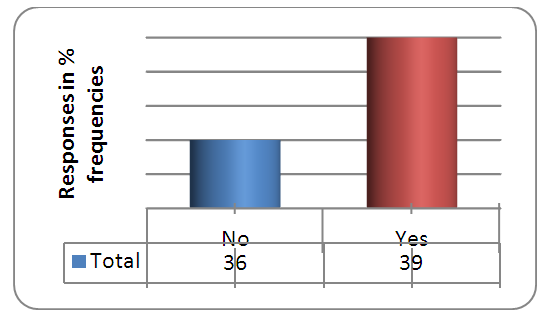 | Figure 4.7. Training on how to use ICT to teach |
4.4.2.2. The Level of Preparedness by ICT Training to Work with Computers
- The Quality received by teacher was also determined by analyzing the responses to the question that sought to find out whether computer training courses prepared respondent well to work with computers. The responses are as captured in Table 4.8 and figure 4.8 below.
|
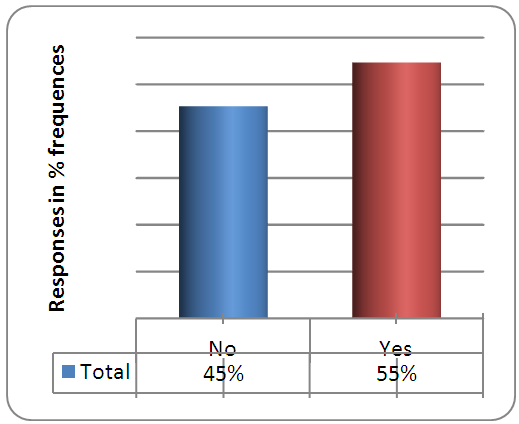 | Figure 4.8. Level of preparedness by ICT training to work with computers |
4.4.3. Most Appropriate Place for Training
- The researcher ran a cross-tabulation of the responses to the items ‘Whether ICT prepared them well to work with computer’ and ‘how training is undertaken’. This was to enable the researcher to establish the institutions which offered the best training among the ones cited by the respondents. The responses are recorded in Table 4.9.
|
4.4.4. Adeptness and Mastery of Computer
- The researcher asked the respondents how comfortable they were with the computers; that is if they were able to do any task that was related to computers and ICT. The responses were as follows in Table 4.10 and figure 4.9 below.
|
 | Figure 4.9. Comfort in working with computers |
4.5. Availability and Use of ICT Infrastructure in School
- Most developing countries lack ICT infrastructure and the teachers have not obtained appropriate training to enable them to use ICT in pedagogy. It had been documented that ICT infrastructure is lacking or is inadequate so the teachers cannot apply the knowledge and skills learnt in their training. This study aimed at establishing the extent to which this was true for Mombasa county schools. The researchers asked the respondents several questions regarding this issue.
4.5.1. Availability of Computers
- The respondents were asked if they had computers in the school’s computer laboratory. The responses are shown in table 4.11.
|
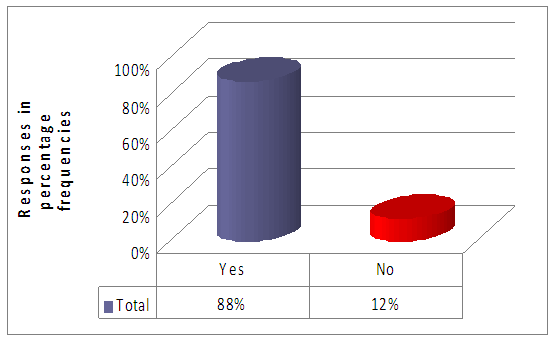 | Figure 4.10. Availability of Computers in computers laboratory |
4.5.2. Internet Connectivity
- The internet is another infrastructure for ICT. The internet is a super highway for transmission of data, source of information through e-books, e-library and a host of teaching and learning materials. Schools can benefit by being connected to it. The researcher asked the respondents if they were connected to the internet. The responses are presented in Table 4.12 and figure 4.11.
|
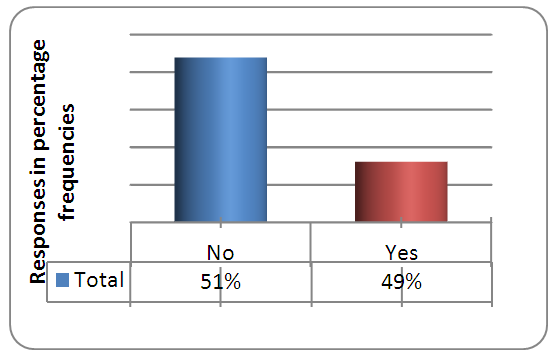 | Figure 4.11. Availability of Internet connections |
4.5.3. Projectors in Schools
- It is very awkward for teachers to teach using one computer, be it a laptop or a desk top as the students would have to crowd around it. This is solved by using an LCD projector. The respondents were therefore asked if their schools had an LCD projector. The responses were as presented in Table 4.13 and figure 4.12 below.
|
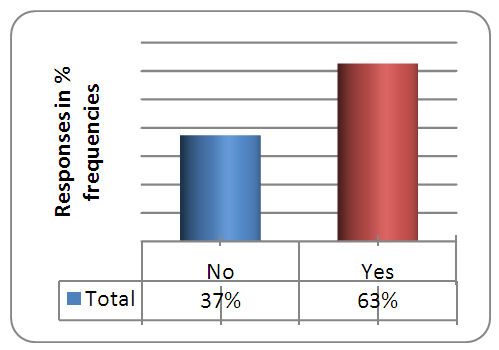 | Figure 4.12. LCD Projector availability |
4.5.4. Satisfaction with Usage of Computers in Their School
- Some respondents indicated that they were satisfied with the usage of computers in their schools, this formed 28 percent, while 27 percent were fairly satisfied and 31 percent were not satisfied. Details of the results are as indicated in table 4.14 and figure 4.13 below.
|
 | Figure 4.13. Satisfactions with usage of computers |
4.5.5. Use of Computers in Teaching
- The respondents were asked if the computers were used by other teachers in their teaching and various class presentations. The responses as provided in Table 4.15.
|
 | Figure 4.14. Usage of computers for class presentation |
4.5.6. Use of Computers in Teacher Preparation
- The computer can be used by the teachers for preparing for their lessons and other teaching and learning materials. Digital encyclopedia like Encarta and Britannica are rich sources of information, especially for Geography, the Sciences and History. The respondents were asked if the computers in the schools were used for research and lesson preparations by the teachers. The responses were as captured in Table 4.16 and figure 4.15.
|
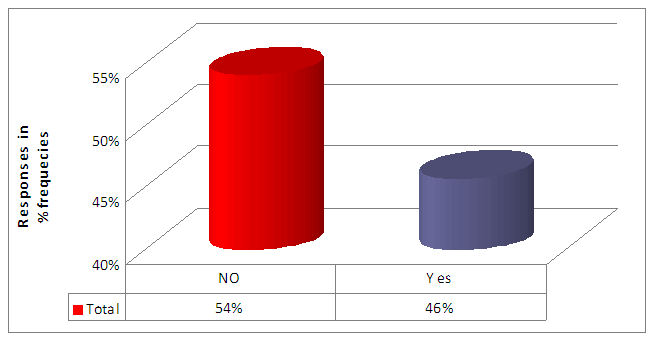 | Figure 4.15. Usage of Computers and internet for research |
4.5.7. Use of Computer Print-out notes
- The computer, through word processors can be used by the teacher to prepare student notes and handout materials. This ensures that the teacher has more time for doing the explanations and clarifications as there is no time needed for students to copy notes. The respondents were asked if they used the computer to prepare such notes. The responses are given in Table 4.17 and figure 4.16.
|
 | Figure 4.16. Satisfactions with usage of computers |
4.6. Challenges of Integrating ICT
- In this study the researcher wanted to know the challenges facing the uptake of ICT in the school in Mombasa County. The researcher asked the respondents to state the any problem or challenge that they have faced as they tried to use ICT in their teaching or enlisting other teachers in embracing ICT in their work. The researcher summed up the challenges as presented Table 4.18 and figure 4.17 below.
|
 | Figure 4.17. ICT integration challenges |
4.7. Solution to ICT Integration Challenges
- The researcher wanted to establish the most appropriate solutions to the challenges faced. The respondents were asked to suggest measures to improve the use of ICT in schools. The suggestions were tallied and ranked to get the frequently mentioned intervention as presented in the following table 4.19 and figure 4.18.
|
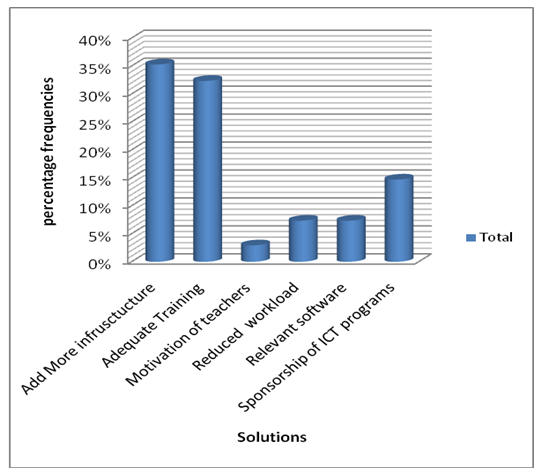 | Figure 4.18. Solutions to Challenges Facing ICT Integration in Schools |
4.8. Answers to Research Questions
- The researcher sought answers to the following questionsQuestion 1: Is needs assessment done for ICT training program offered to teachers’ in Mombasa County? The answer to this question is that needs assessment is not done. Most of the beneficiaries to the ICT training take their own initiative to acquire ICT knowledge so as to be able improve on their personal professional growth. There is little official programmatic effort to enhance ICT skills among the teachers. Question 2: what modes of ICT training programs have been offered to teachers in Mombasa County?There are various training modes available to teachers in Mombasa County who wants to train in ICT but the best mode according to this research, is the training received at the teacher training colleges and universities, the second best mode is In- service while the worst is evening classes.Questions 3: Which ICT infrastructures are available in secondary schools in Mombasa County? The answer to this question is that the most available infrastructure is the computers per se, the supportive infrastructure, the soft structures in particular, are conspicuously lacking. The computers available are also not enough as most respondents who sighted inadequate infrastructure as a challenge talked of classes being large and computers being few. Internet connectivity is still not available in most secondary schools.Question 4: What are the challenges in the use of ICT in schools in Mombasa County? The answer to this question is that, inadequate infrastructure, inadequate training, and inadequate teaching time were the major challengesQuestion 5: What are the solutions to the use of ICT in schools in Mombasa County? The suggested solutions were linked to the challenges. The addition of infrastructure was cited as the solution to inadequate infrastructure while sponsorship to ICT training program was suggested as the solution inadequate training.
5. Discussions
- Most of the teachers who are conversant with ICT in the secondary schools in the Mombasa County are male. There is need to encourage more female teachers to take up ICT training because they will need it to enhance learning as well as for them to act as role model to the girl child so as not to shy away from technology. Teachers who teach mathematics are the most conversant with ICT in schools in Mombasa County. There is no reason why teachers for other subject apart from mathematics should not integrate ICT in learning, there is a lot of information for all the subjects that can be accessed by both teachers and students from the internet. There are several avenues through which teachers can acquire ICT skills but evening class trainings are not suitable for teachers in acquiring ICT skills related to teaching. Teacher should be given ample time to learn the skills adequately. The current ICT training being offered by most institutions is ineffective in building the capacity of teachers in secondary schools to effectively integrate ICT in teaching and learning process. This research also revealed that not all teacher training colleges and education departments in the universities have ICT as one of the courses for the trainee teacher. The ICT policy should set standards of training, objective to be achieved and outcomes to be expected. It should be made mandatory for every teacher to acquire the standardised ICT training and use it teaching and learning process.Most schools in Mombasa County have computers but do not have the internet connections hence not getting the full benefit of having computers in the schools. Computers in most schools are under-utilized as teachers did not use them for teaching or preparing for classes or lesson notes may be due to limited or lack of internet connection. Teachers are ready to embrace pedagogy- ICT in their work but they do not have the facilities such as fast internet connection which would open the world to leaning through interaction and research. The current training of teachers in the ICT is haphazard hence the teacher is not able to fully utelise ICT facilities in cases where such are available. This should be streamlined by the ministry of education.
6. Conclusions
- The Ministry of Education should encourage affirmative action to bring gender parity in ICT proficiency among teachers in the Mombasa County. All teachers in all subjects taught in secondary schools should be encouraged to use ICT to teach and digital content for all subjects should be developed. Teachers should be discouraged from enrolling for ICT in the private commercial colleges which purport to offer computer training. The government should vet such computer training colleges in order to weed out quack institutions. Furthermore these commercial institutions are only geared for computer literacy skills and are ill equipped for pedagogy-ICT integration. The teacher training colleges and education departments in the universities should have pedagogy- ICT integration as one of the core courses to the learnt by the trainees. Teachers can be facilitated to acquire pedagogy-ICT integration skills by having more ICT infrastructure and sponsorship for ICT training programs that address this need. Efforts should be made to motivate more teachers to gain skills in the use of ICT in teaching and learning process. One such motivation is, in involving teachers in digitising the curriculum and developing digital content that is suited to prepare students for the 21st century. Schools can endeavor to have internet connections in order to get the full benefit of having computers in the schools. The teachers should use ICT for delivering curriculum materials, research, class presentation and lesson notes since this will improve creativity, innovation and collaboration among teachers and students hence enhancing their performance. Mombasa county and government at large should come out clearly on policy on capacity building of teacher in pedagogy- ICT integration, for example there should be a specific curriculum derived from need analysis, to be followed by the training institutions and outline set standards to be obtained by the trainees. The Government of Kenya and her development partners should invest in ICT in schools by providing relevant ICT infrastructure but this should be done strategically, that is after careful analysis and planning to in order to meet the specific needs and create synergies.
7. Recommendations for Further Research
- Researchers should assess the impact of teacher ICT training curriculum on integration of ICT in pedagogy in schools. Researchers could also find out how teacher training in pedagogy- ICT integration can be improved to enhance their performance and professional development. Research can also be done to establish the impact of teacher ICT training policy on teacher performance. Impact of teacher motivation on the pedagogy –ICT integration in secondary schools is another area where research could also be done.
ACKNOWLEDGEMENTS
- I wish to express my deepest gratitude and warmest appreciation to the following people who have in one way or another, inspired me and contributed to the completion of this research project; Lucy Gichinga, who has been my supervising lecturer, for her timely guidance and unwavering support throughout the process of writing this search project. My Family members Jardine, Ken, Samba, Moses, Agnes, Brown for their support and understanding when I spent less time with them as I got engrossed in this research project. My colleagues in various schools in Mombasa County who made it possible for me to collect data in the sampled secondary schools.
 Abstract
Abstract Reference
Reference Full-Text PDF
Full-Text PDF Full-text HTML
Full-text HTML

